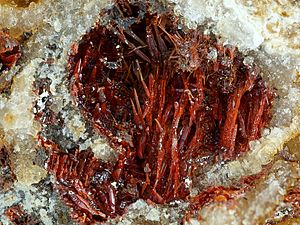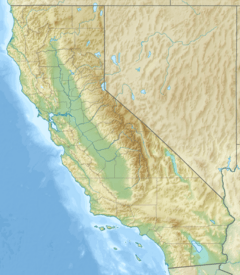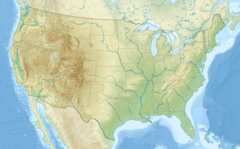Castle Rock Springs, California facts for kids
Quick facts for kids
Castle Rock Springs
|
|
|---|---|

Montroydite from the Socrates Mine in the Castle Rock Springs area
|
|
| Country | United States |
| State | California |
| County | Lake County |
| Elevation | 2,342 ft (714 m) |
Castle Rock Springs was once a popular vacation spot in Lake County, California. It was built around several special springs that had natural minerals in their water. One of these was a hot spring with lots of water!
Over the years, this place had many different names. Some of them were Mills Hot Springs, Noble's Springs, Castle Springs, and Verdant Vales.
Contents
Where is Castle Rock Springs?
Castle Rock Springs is located in Lake County, California. It is about 7 miles (11 km) northwest of Middletown. You can also find it about 3 miles (4.8 km) south of Whispering Pines.
The springs are high up on a mountainside. They are above the hot springs at Anderson Springs. Anderson Springs is 1 mile (1.6 km) to the east and about 800 feet (240 m) lower. Castle Rock Springs itself is at an elevation of 2,342 feet (714 m) above sea level.
The buildings for the resort were built on a ridge. This spot was about 1⁄4 mile (0.40 km) away from the hot springs. It offered a beautiful view of the Putah Creek valley and the mountains to the east.
What Kind of Springs Are There?
The area around Castle Rock Springs has several different kinds of natural springs. These springs bring water up from deep underground.
Hot Springs
Around 1910, people had dug out and cemented two hot springs. These springs were only a few yards apart in a small valley. The water in these basins was very hot, about 160 and 164 °F (71 and 73 °C). Together, they released about 8 US gallons (30 L; 6.7 imp gal) of water every minute. The water had a mild sulfur smell but not many other minerals.
The biggest hot sulfur spring was in a small canyon above where the hotel used to be. In 1914, this spring released about 40,000 US gallons (150,000 L; 33,000 imp gal) of water every day! The water came out of the ground at a very hot temperature of 163 °F (73 °C). This hot water was sent through pipes to the bathhouse and the swimming pool. There was also a smaller hot spring nearby, with water at 153 °F (67 °C).
Other Springs
Besides the hot springs, there were other springs on the property. Each had its own temperature:
- Sour Spring: 65 °F (18 °C)
- Black Sulphur Spring: 67 °F (19 °C)
- White Sulphur Spring: 66 °F (19 °C)
- Vangas Spring: 66 °F (19 °C)
The Vangas spring area had a lot of hydrogen sulfide gas escaping from the ground. This gas often smells like rotten eggs.
History of Castle Rock Springs
The springs were first found around 1885 by someone named W. Mills. Because of this, they were first known as Mills Springs or Noble's Springs.
Early Resort Days
At first, the property was a small resort. People used the hot water for bathing. They drank the cool sulfur spring water, believing it had health benefits. By the summer of 1910, the resort had new owners. They started making many improvements. They built a hotel, a bathhouse with a swimming pool, and a dancing pavilion. They also set up several tent cottages for guests to stay in.
A post office called Castle Springs operated here from 1911 to 1917. By 1913, after some legal issues, Mrs. Campbell-Van Luven owned the property. She planned to reopen it for the 1914 season. A large, new swimming pool, 25 by 60 feet (7.6 by 18.3 m) and lined with cement, had just been built. The hotel and cottages could host up to 75 visitors.
Geothermal Area
The Castle Rock Springs area is also known for its geothermal steam. This means there's a lot of very hot steam deep underground. This steam can be used to create electricity. It is right next to The Geysers, which is a very large area where geothermal energy is produced.
In the past, the tourist resorts in this area eventually closed down. However, some of the old resort buildings were later used by special private religious groups.



